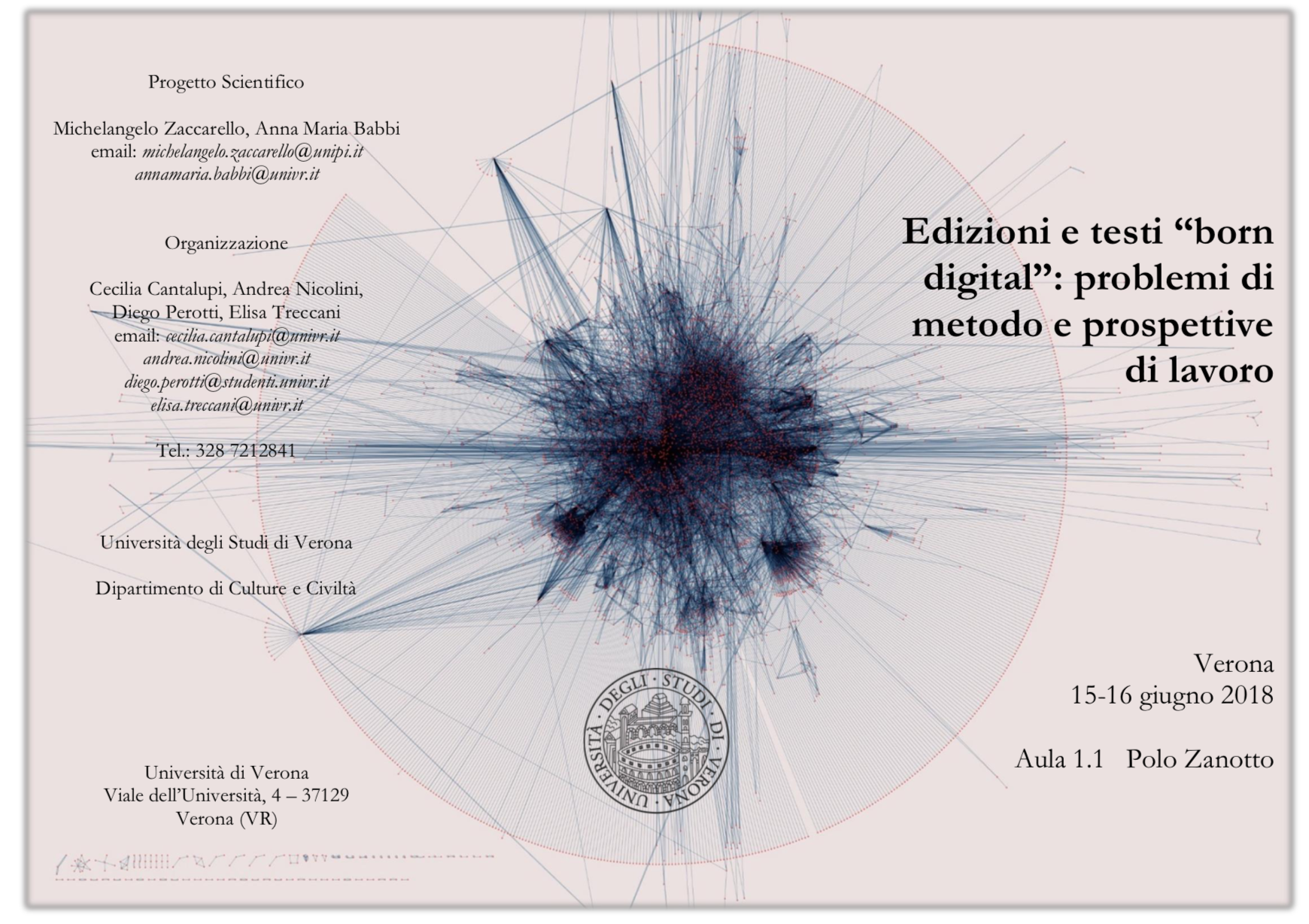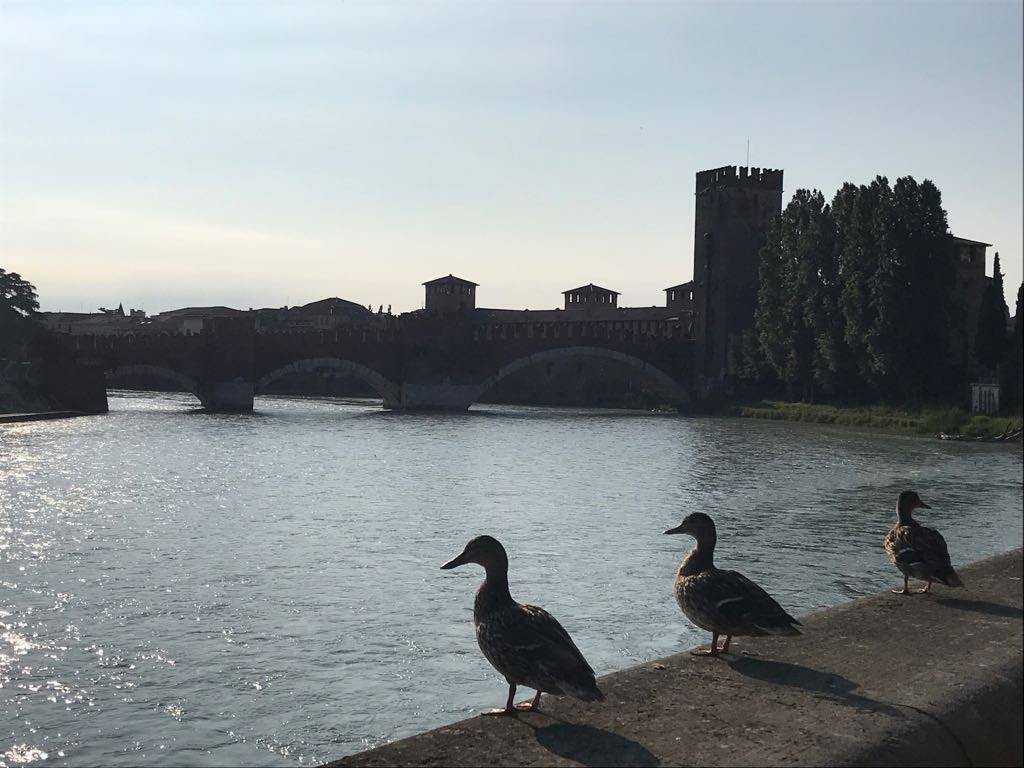Born digital editions and much more at a mid-summer conference in Verona
In this blog post, Simone Ventura describes a recent conference he attended in Verona. He tells us about the interesting and varied papers he heard and reflects upon what this means for the digital editions we're creating of the Histoire ancienne jusqu'à César.

The beautifully-designed poster for the Verona conference.
In June, a conference took place in Verona, a stunning city in Northern Italy. The hosts and souls of the event were Anna Maria Babbi and Michelangelo Zaccarello, who organised this conference with the help of a small army of highly skilled young medievalists.

Castelvecchio, Verona at 7am
The subject matter of the conference, editions of texts 'born digital', is obviously relevant to TVOF. Under the lead of Hannah Morcos, we teamed up with Geoffroy Nöel, Paul Caton and Ginestra Ferraro to digitally edit the Histoire ancienne jusqu’à César. Our edition is also digitally born, of course. In his recent words to the members of the TVOF seminar (which took place on Friday, June 22nd), Geoffroy Nöel described the edition of the HA as a scripted journey from TEI-XML to a rich web publication via a computer assisted editorial workflow. Every two hours, Geoffroy’s ‘invention’ transforms our 37 ‘source files’, in which the text of the manuscripts of the HA has been transcribed and encoded, first into a single aggregated file, next into a single converted file which then becomes visible in our Text Viewer.
Verona was an opportunity for me to see how colleagues both inside and outside the field of Medieval Studies were dealing with digital editing of a wide variety of texts from the Middle Ages to the present day—I am thinking about Paola Italia's fascinating paper where, alongside the presentation of a promising online resource on Alessandro Manzoni, she made some astute observations about the way in which one of the most important textual databases of Italian literature, Biblioteca Italiana, treats and sometimes mistreats the Italian twentieth-century novel.
Every text and textual tradition is unique and presents specific problems to the editor. Several decisions must be taken according to an ever-increasing number of variables: the historical and cultural coordinates of the text(s) to be edited; the aims of the research project in which the edition is framed; how the ‘new’ digital edition relates to pre-existing editions. Indeed the issue of how the new and the old are combined in current digital editing was at the heart of several papers at the conference.
Elena Pierazzo and Michelangelo Zaccarello authored the most ‘political’ of the papers delivered in Verona. Moving seamlessly between Paul Eggert, David F. Greetham, Matthew G. Kirschenbaum, and Jerome McGann, Michelangelo Zaccarello addressed issues of obsolescence in the digital era. Elena Pierazzo’s passionate and ‘a-technological’ paper (with just her own text and not a powerpoint presentation in sight!) focused on what should be done to make digital editions sustainable, lasting and easily accessible to the scholarly community. Traditionally, the digital in the humanities has been synonymous with innovation. And innovation means funding. This is having the perverse effect of making funding agencies award grants only to digital editing projects that prove their innovative and ground-breaking potential. The consequence of this is twofold. First, paraphrasing Elena Pierazzo, every time we embark on a new project we tend to reinvent the wheel. Secondly, Michelangelo Zaccarello reminded us how the 'tyranny of the new or the novel' accelerates the process by which the accumulation of data in any edition (with its considerable amount of very often carefully and rigorously stored data) ends up as garbage, feeding gigantic dumps all over the world.
![Pile of Waste - Electronic Waste Documentation (China: 2007) [source Google, last access: 27/06/2018]](/media/images/ewaste.original.jpg)
Pile of Waste - Electronic Waste Documentation (China: 2007) [source Google, last access: 27/06/2018]
Obviously the digital is not the new. And the ground-breaking does not necessarily derive from a brand new ‘toy’. The oldest digital editions are now thirty years old. The digital has been around for a while and will remain so. From their respective standpoints, Elena and Michelangelo advocated the patient work of consolidating what we have already developed during a period spanning more than a generation. What we should do is learn from our past experiences, including the many shortcomings and, sometimes, clear failures that we have faced in our short history of digital editing. We should not build something unsustainable and essentially inert once the flow of money is cut off, but rather make the most of our current resources to render digital editing a real, trusted tool for research and a credible alternative to the 'technology' of the book.
At the conference, we got a taste of some of the technological cooking that is going on in European digilabs. Based in Pisa, Roberto Rosselli del Turco’s Edition Visualisation Technology (EVT) is an amazing attempt to make digital editions a real possibility for all those wishing to create an edition of a medieval text in any language (Romance and Germanic, but also Arabic, Chinese…). Roberto showed how the TEI critical apparatus module has been used in EVT development to represent a dynamic text, whereby the ‘critical’ text is always displayed in such a way that it occupies one half of the screen while in the other we can easily see the critical apparatus.
With her usual volcanic creativity, Tiziana Mancinelli is doing a great job in helping Antonio Montefusco make a reality of his ERC Advanced Grant Project Biflow (Bilingualism in Florentine and Tuscan Works, ca. 1260 – ca. 1416). Tiziana Mancinelli is working on the Digital Edition of the Documenti d'Amore. Mancinelli is developing a tool-kit that enables the edition of the text(s), their comparison and the possibility for the user to navigate through the stunning Vatican manuscript Barb. lat. 4076: an autograph and an extraordinarily beautiful codex of Francesco da Barberino’s Documenti d’Amore (dating from the start of the 14th century).
Francesca Tomasi showed us the edition of a previously unedited ten-year diary of the Italian politician, partisan and intellectual, Paolo Bufalini. Bufalini’s notes on various matters are packed with quotes from Latin authors and German philosophers. Tomasi showed us her intellectual and technological trajectory to model and represent this web of knowledge recorded by Bufalini. At the centre of her project is so-called ‘linked data’, which, in the context of Francesca’s presentation, could be thought of as an attempt to switch from a hierarchical to a graph model of knowledge creation and representation. For an illiterate like me, it is difficult to do justice to and convey the sheer beauty of the abstraction that lies behind something like the Resource Description Framework (RDF) and its host of ‘specifications’, which is allowing more and more people to deal with the issue of how to link the body of knowledge on the web with what we know through other media, like, for example, the diary of a politician with a great passion for Horace.
Peter Stokes is now at the EPHE, but used to work at KCL, where he created Digipal, a resource for the study of medieval handwriting. With that rare lucidity that makes even the most difficult things appear clear and straightforward, Peter Stokes introduced us to some of his most recent research interests, namely the practice of ‘identifying one scribe writing very different scripts', and how this work on digital palaeography is changing the fundamental questions we ask about script recognition, scribal attribution, and the very status of palaeography and manuscript studies.
Simone Rebora works alongside Massimo Salgaro at Verona. In a rich presentation, he surveyed the virtues and limitations of the latest OCR software, while looking deeper into the maths of current stylometry. Optical Character Recognition software development is making solid progress and soon not just modern printed texts but also medieval manuscripts could be automatically converted into machine-encoded text. It was interesting to see how the software makes the machine learn from its own very practice: by repetition of the same ‘gesture’, the software teaches the machine how to distinguish a long ‘s’ from an ‘f’ in old print or indeed in manuscripts. Of course, there’s still work to be done. The software is not yet able to avoid those little mistakes that can have quite serious consequences. In German taking a ‘k’ for an ‘s’ makes a difference: it's one thing to ascribe an idea to someone (seine Idee), and quite another to state that this someone has no idea whatsoever (keine Idee).
Elisa Guadagnini and Riccardo Viel offered a different approach to digital editing and digital work on medieval textual traditions. Expanding on their experiences as linguists and philologists, they both gave us a glimpse of how the tool-dimension of the digital is just an aspect of the ways in which the digital is organically integrating research agendas and practices. Riccardo showed us how Trobvers, a database of troubadour lyric developed at the University of Calabria, considerably changed his understanding of one of the most important and beguiling troubadours, Giraut de Borneil. Elisa showed how the process of encoding the corpus of Old Italian texts of the Opera del Vocabolario Italiano (OVI), led to some of her most important research findings. She took us on a fascinating journey through some of the medieval renderings of the Greek term for ‘political’ in the famous passage from Aristotle’s Politics in which human beings are qualified as political animals:
ἐκ τούτων οὖν φανερὸν ὅτι τῶν φύσει ἡ πόλις ἐστί, καὶ ὅτι ὁ ἄνθρωπος φύσει πολιτικὸν ζῷον (Aristotle, Politics, I 1253a)
[From these things therefore it is clear that the city-state is a natural growth, and that man is by nature a political animal]
Aristotle’s statement soon became proverbial. At the end of the 13th century, it was variously translated into many vernaculars. Most famously Dante wrote in the Convivio:
E però dice lo Filosofo che l’uomo naturalmente è compagnevole animale. (Convivio, IV, iv, 1)
[And this is why the Philosopher said that man is naturally a 'companionable' animal]
Using the OVI database as a ‘relevant corpus’, Elisa Guadagnini demonstrated that Dante’s translation of Giles of Rome’s homo est naturaliter animal sociale (= Aristotle’s πολιτικὸν ζῷον) as compagnonevole animale was not based on an idiosyncratic choice—compagnonevole was neither a Gallicism nor a ‘peripheral’ word in Dante’s Tuscan. Far from being a lexical choice estranged from the ‘normal’ vocabulary of late-medieval authors writing in Italian, and against present ‘philological’ common sense, it was precisely the now-obsolete Italian word compagnonevole, and not the currently more common word sociale, that occupied, in Elisa Guadagnini’s lexicological model, the unmarked core of Dantean (and his contemporaries’) vocabulary.
An afterword from Mirko Tavoni marked the end to this memorable conference, for which I want to take the opportunity to thank once again the organisers and the people that made it possible.
Simone Ventura
(Very Essential) Bibliography
Cosimo Burgassi – Elisa Guadagnini, La tradizione delle parole, Strasbourg, ÉLiPhi, 2017
Elena Pierazzo, Digital scholarly editing: Theories, models and methods, Aldershot: Ashgate, 2015.
Peter Stokes, ‘Scribal Attribution across Multiple Scripts: A Digitally Aided Approach,’ Speculum 92 (2017), S65-S85 [= special issue Speculum, Volume 92, Number S1 | October 2017, The Digital Middle Ages]
Michelangelo Zaccarello, ‘La letteratura italiana nel contesto della svolta digitale: serve più “teoria dell’edizione”?’, Ecdotica 14 (2017): 148-161.